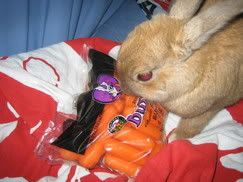PIPECLEANERS.
Fun to play with. You can make all sorts of crafty things with them. But do not put them in the microwave. They are not microwave safe.
Before you pass judgement...
This is the first time i have EVER started a fire...
that wasn't intentional, i mean...
and in the microwave.
And I've been playing with fire for a very long time.
Friday, December 16, 2005
PUBLIC SERVICE ANNOUNCEMENT
Thursday, December 08, 2005
Is it a mite?
I found this on a float yesterday :
(for those of you who just HAD to know :
the fecal sample came from a young male cat that came in for a neuter. He also had roundworms--sorry no pictures of those, I'll post worm pictures another time I promise!! )
The Biting Lice (Mallophaga)
The Mallophaga are described as wingless (Apterous), hemimetabolous (having a simple metamorphosis i.e. no pupa) ectoparsites (living on the outside of their hosts) of mostly birds but also of some mammals. The range in size from 0.5 to 10 mm long. Their mouthparts are designed for biting.
Most feed on fragments of hair and feathers. Some have formed a symbiotic relationship with bacteria, these may help with the digestion of blood etc as individuals deprived of their bacteria die in a few days. They are often adapted to live on particular parts of their hosts bodies. They can only survive for a maximun of three days after their host has died and may hitch a ride on a pasing fly (phoresis) in the hope of reaching a new host, they may also use phoresis in order to spread to a new host even if the present one is still alive.
Females lay up to 100 eggs which are cemented to the hair or feathers of the host with a clear fast drying glue which is secreted onto the hair or feather by the female immediately before she lays the egg. The eggs take about 3 or 4 days to hatch and the nymphs go through 3 larval instars in about 20 days before they reach maturity.
Monday, December 05, 2005
MY HAT
I just finished it. Right now. I hate it. It took me entirely too long to make it. I kept making boo boos so I had to do it over and over and over. And it still has boo boos. I really hate this hat right now and I want to burn it.
But it's cold out and it might snow. I cant go out there without a hat!
I have to know:
Is it too fugly to wear in public?
What if it snows? Would it be less fugly if it was snowing? Is there a minimum amount of snow that must fall before I can wear this hat out in public?
We're supposed to get 3-5 inches. I've been watching the weather updates and they say, at times it *COULD BE* heavy!!! What if I only wore the hat during these "heavy" times.
It may be ugly but its warm and soft
Or maybe I'll just order in chinese...

